How To Repair Trim Molding
Trim boards, also chosen molding pieces, gracefully cover joints between different surfaces and materials. The most common applications are casings around windows and doors and base moldings at the bottom of a wall.
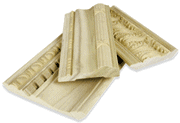
Crown molding is sometimes used to dress upwardly the articulation where wall meets ceiling, and various decorative trims, including chair runway and picture molding, are used to add involvement to a wall or ceiling. If you enjoy installing or repairing a fireplace pall, staircase parts, wainscoting or paneling, you volition find a wide variety of trims made to suit those situations.
Trim pieces are identified by their profiles- how they expect when viewed at their ends. You lot tin can find profile charts at home centers and from online suppliers to help you choose the right board for your purpose.
Interior Trim Types
The word "trim" refers to well-nigh every applied decorative element you can think of, including baseboard, door and window casings, chair rail, flick rail, crown molding, pediments, pilasters, columns, ceiling medallions, corbels, spandrels, mantels, and fireplace surrounds.
Some trim is simply flat boards-one x two battens, for instance. But much of what we remember of as trim is molding, in which a shape-a profile-is carved into the surface of a flat board. There are literally hundreds of profiles to cull from, although you may find merely the most popular ones in stock at your local supplier.
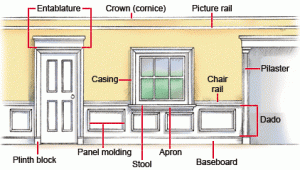
Trim and moldings are generally divided into categories according to where they announced on the wall (although some pieces can serve a dual purpose, such as a baseboard that is used as a door casing). Oft different kinds of trim are combined to create a congenital-up molding, particularly a crown.
Baseboard covers the intersection between the flooring and wall and protects the bottom of the wall from such things every bit a moisture mop or a vacuum cleaner. The profile of the baseboard is generally deeper (wider) at the lesser than at the summit. Except in unique situations, baseboard is plant in about homes.
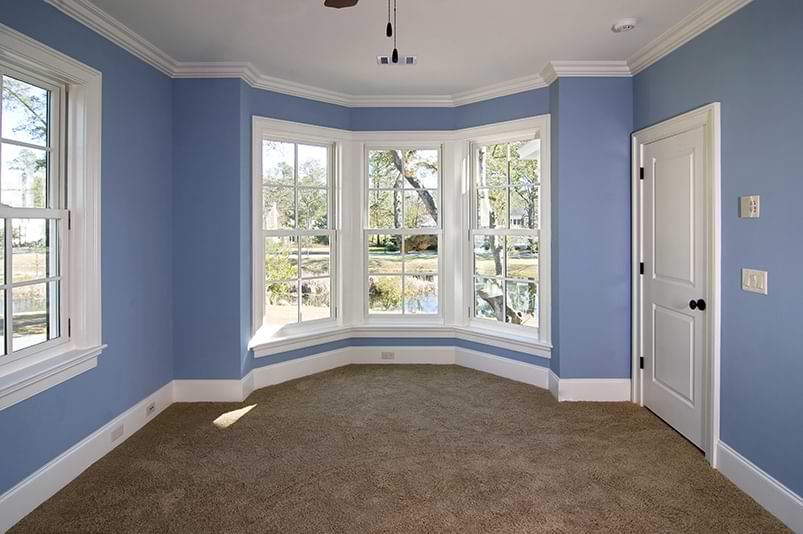
Base of operations shoe is a quarter-round trim. Its two apartment sides form a 90-caste angle that fits against the floor and the baseboard; its 3rd side is rounded. In profile, it looks similar a quarter circle. Base shoe elaborates the baseboard slightly only also serves to cover any gap between the baseboard and flooring material.
Ceiling molding (as well called cornice or crown molding) covers the intersection between the wall and ceiling. Flat- backed types are practical at the top of the wall, butting against the ceiling. Crown molding, which is a sprung molding, crosses the intersection at an bending then its back is in three parts-a broad, flat central expanse and angled edges.
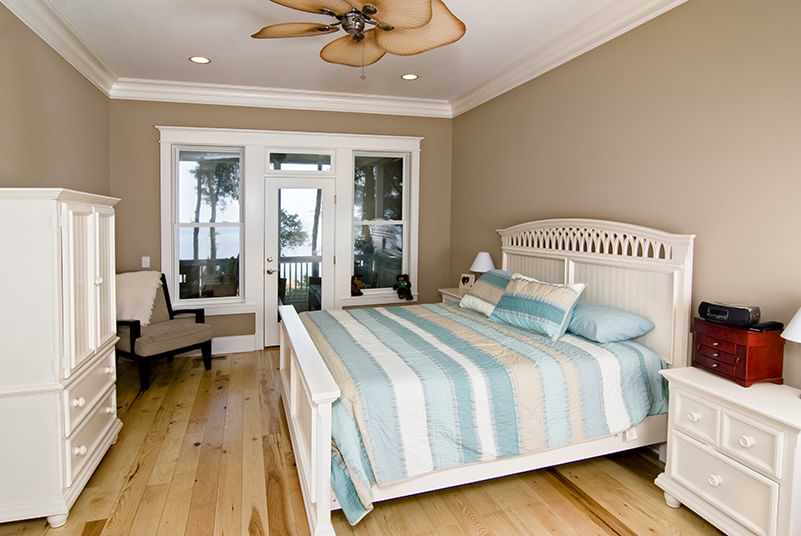
Door and window casings create a frame effectually the door or window opening and hide the gap between the jamb and the next wall. The outside border of the casings is ordinarily flat, to provide surface for horizontal trim-such as a chair rail-to barrel into cleanly.
Wall paneling tin cover an entire wall or a portion of it. Information technology can be made using frames, panels, bead board, tongue-and-groove boards, or plywood and battens, depending on the mode you wish to attain. Generally, if the paneling doesn't comprehend the unabridged wall, it is called wainscot and runs either 1-third or two-thirds of the way up the wall.
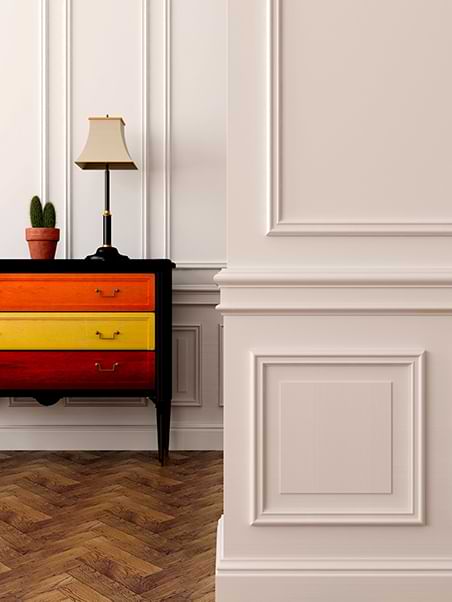
Cap molding and back ring have rabbeted edges that fit over the tiptop of wall paneling or the outside of apartment casing.
Chair rail is applied approximately 36 inches from the floor. It functions to protect walls from the backs of chairs, simply it is besides used as a segmentation between paint and wallpaper or two different colors of paint, or just to create a visual suspension in the wall.
Picture show molding has a rounded pinnacle border to suit hooks. It is positioned loftier on the wall and so artwork tin can hang from it rather than from flick hooks nailed into the wall.
Tips for Choosing Interior Trim
To use trim finer, information technology's best to follow a few bones precepts:
Use Trim Consistently
Your dwelling will wait best if all the trim work conforms to a single architectural way. Formal rooms, such as living rooms, may have more trim-wall paneling, a chair rail, or fancy cornices-than bedrooms, just all the trim should be of a consistent style.
Throughout your house, exist careful not to get overboard with trim. Too much can overpower a room and detract from all other interior elements, decreasing rather than adding to your home'southward attractiveness and value.
Make Sure All Trim Elements Go Together
Within any fashion of trim, there are a number of choices. Peculiarly where trim pieces intersect, your selections demand to be suited to ane some other. For example, baseboard and chair rail should never be thicker than door and window casings.
The vertical pieces on a paneled wall should never be thicker than the horizontal trim they abut. In cases such every bit where a plate runway meets a window casing, the end of the rail needs to be finished with a render and then the end grain is covered.
Develop Your Adroitness
Woodworking skills are important when it comes to installing trim. Narrow gaps are almost ephemeral when filled and sanded, but wide gaps and uneven cuts offend the eye. This is especially true with woods that will be stained rather than painted. If you are going to install the trim yourself, experiment with cuts and joints on flake woods before working with the real thing.
Keep Information technology to Scale
The size of your trim and moldings should be in proportion to the size of your rooms. Unfortunately, at that place are no formulas to help you make up one's mind what's right for whatsoever specific situation.
Equally a dominion of thumb, the baseboard and crown molding should exist in balance and so that one doesn't overpower the other. In rooms with a standard 8-pes-high ceiling, no baseboard or crown should be more than than 6 inches tall. Most trim between 3 ane/2 and 6 inches in height works well in these rooms.
Higher ceilings demand taller and deeper trim. In rooms where ceilings are extremely high, vi inches is the minimum height for baseboard and crown molding. If the doors in such a room are standard size, you can make them seem larger past installing wide casings or calculation decorative treatments such as a pediment to a higher place or pilasters alongside them.
Establishing scale and proportion is a challenge, specially in a unique situation. If y'all don't trust your own eye to guide you, you lot might want to hire a designer to specify what you should use and where you should place it before you invest in the material.
![]()
Interior Trim Materials
Forest trim is usually clear, meaning information technology has no knots, which (unless you lot are installing knotty pine paneling) would mar the appearance.
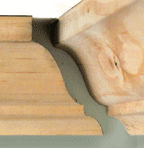
Though moldings made of other materials are available, woods remains the most common material for trim boards. At a home heart or lumberyard, you volition find at least some of these options:
- Hardwoods make the all-time trim. They resist warping and peachy and can be stained to a beautiful finish. Information technology is normally best to use the stain before installing the piece, and so to touch upwardly the cut edges and apply the final cease.
- Pine has long been the most mutual trim fabric. Information technology resists cracking and remains stable. It ordinarily has broad grain lines, meaning that information technology will take an informal appearance if stained. That'southward why it's usually painted. Pine is soft and so may be easily dented.
- Poplar is a bit more than expensive than pino, only information technology is harder and more resistant to denting. Information technology has a closer grain, so you may be able to stain information technology satisfactorily. Still, poplar is commonly painted.
- Paint-course trim is definitely meant to exist painted rather than stained and is less expensive than clear pine or hardwood. Some types come up primed, which is a large plus-you tin probably get away with applying only one glaze of paint rather than the two or 3 usually needed for bare wood. Pigment-grade pieces are fabricated of various materials.
- Finger-jointed boards are manufactured by joining together short pieces. The finger articulation will be unattractive if stained, then these boards are usually painted. Some finger-jointed boards are better than others. Feel the joints to be sure they are perfectly smooth; if not, the joints may be visible even later painting.
Trim for Older Homes
When working on an older home, you may demand to friction match a trim profile that is no longer sold. In this case you have three basic options:
- Use 1 or more pieces of off-the-shelf trim that are similar to the onetime trim. Sometimes, combining ii narrow pieces tin can mimic the look of 1 wider slice. This may exist close plenty that the departure is unnoticeable.
- Take a lumberyard custom-manufacturing plant pieces for you. At that place will be an initial charge for setting upwardly the "knives" used for milling the profile. Other than that, the cost per lineal foot will not exist as well bad. Of course, that means that custom milling is expensive if you but need a few pieces but becomes more than reasonable the more boards you buy.
- Start with articulate lumber and factory it yourself. Utilise a router with router bits that match or come up close to the profile you are later on.
If your home has an Arts and Crafts style, y'all may find that much of the trim is foursquare cutting. In that case, you might exist able to use clear 1-by boards (which after milling are 3/4 inch thick), or inquire a lumberyard to mill boards that are a bit thinner or thicker.
Discover a Pre-Screened Local Interior Molding and Trim Pro
Source: https://www.hometips.com/buying-guides/trim-types-interior.html

0 Response to "How To Repair Trim Molding"
Post a Comment